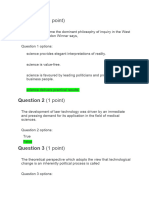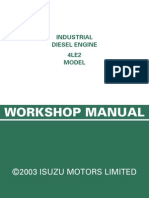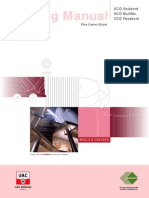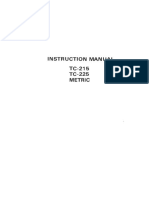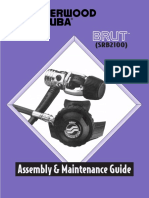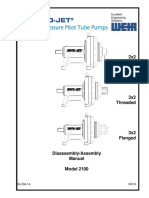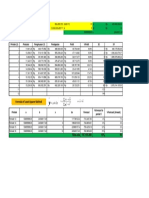Goebor S Operating Instructions
Goebor S Operating Instructions
Uploaded by
Elgi Zacky ZachryCopyright:
Available Formats
Goebor S Operating Instructions
Goebor S Operating Instructions
Uploaded by
Elgi Zacky ZachryCopyright
Available Formats
Share this document
Did you find this document useful?
Is this content inappropriate?
Copyright:
Available Formats
Goebor S Operating Instructions
Goebor S Operating Instructions
Uploaded by
Elgi Zacky ZachryCopyright:
Available Formats
Atlas Copco Geotechnical Engineering Products
Operating instructions
Terracore geotechnical core drilling tools
- S Geobor wireline core barrel
S Geobor wireline core barrel
Contents
Introduction . . . . . . . . . . . . . . . . . . . . . . . . . . . . . . . . . . . . . . . . . . . . . . . . . . . . . . . . . . 4
1. Product description . . . . . . . . . . . . . . . . . . . . . . . . . . . . . . . . . . . . . . . . . . . . . . . . . . 5
1.1 Description. . . . . . . . . . . . . . . . . . . . . . . . . . . . . . . . . . . . . . . . . . . . . . . . . . . . . . . . . . . . 5
1.2 Method 1-7 description . . . . . . . . . . . . . . . . . . . . . . . . . . . . . . . . . . . . . . . . . . . . . . . . . . 5
1.3 Technical data - wireline core barrel . . . . . . . . . . . . . . . . . . . . . . . . . . . . . . . . . . . . . . . 7
1.4 Technical data - rods. . . . . . . . . . . . . . . . . . . . . . . . . . . . . . . . . . . . . . . . . . . . . . . . . . . . 7
1.5 Technical data - drill bits. . . . . . . . . . . . . . . . . . . . . . . . . . . . . . . . . . . . . . . . . . . . . . . . . 8
2. Operating instructions . . . . . . . . . . . . . . . . . . . . . . . . . . . . . . . . . . . . . . . . . . . . . . . 9
2.1 Basic setting of the core barrel. . . . . . . . . . . . . . . . . . . . . . . . . . . . . . . . . . . . . . . . . . . . 9
2.2 Drilling. . . . . . . . . . . . . . . . . . . . . . . . . . . . . . . . . . . . . . . . . . . . . . . . . . . . . . . . . . . . . . . 10
2.2.1 Recommended drilling parameters . . . . . . . . . . . . . . . . . . . . . . . . . . . . . . . . . . . . . 10
2.3 Catching and lifting the inner core barrel . . . . . . . . . . . . . . . . . . . . . . . . . . . . . . . . . . 10
2.4 Installing inner core barrel (water filled hole). . . . . . . . . . . . . . . . . . . . . . . . . . . . . . . 10
2.5 Installing inner tube assembly (dry hole) . . . . . . . . . . . . . . . . . . . . . . . . . . . . . . . . . . 10
2.5.1 Using Dry-Hole device as overshot . . . . . . . . . . . . . . . . . . . . . . . . . . . . . . . . . . . . . 11
2.6 Overload protections - optional safety device . . . . . . . . . . . . . . . . . . . . . . . . . . . . . . 12
2.7 Pilot coring 4" (101 mm) hole . . . . . . . . . . . . . . . . . . . . . . . . . . . . . . . . . . . . . . . . . . . . 12
2010 Atlas Copco Craelius AB | No. 6991 1721 01 | 2010-06-22
S Geobor wireline core barrel
Introduction
These instructions are intended for operators of the Atlas Copco equipment. The aim of the
instructions is to provide you with knowledge of how to use the equipment in an efficient
and safe way. These instructions also give you advice and tell you how to perform regular
maintenance on the equipment. It does not replace thorough training of operator, it is a
complement. For further information concerning service measures, please contact your
nearest Atlas Copco representative.
Always read these instructions carefully and make sure that you understand all of them
before starting for the first time.
The owner of the equipment is granted the permission to take copies of this publication
solely for internal use. It is recommended, however, to order additional copies from Atlas
Copco representative in order to benefit from the latest revision. Atlas Copco Craelius AB
reserves the right to make changes in its products in order to improve design or performance
characteristics without notice. The information in this publication is assumed to be accurate at
the time of publication, but is subject to changes in order to remedy detected deficiencies or
to follow changes in the product.
Any user of this publication is requested to inform Atlas Copco Craelius AB about deficiencies
found, particularly in matters concerning product safety.
2010 Atlas Copco Craelius AB | No. 6991 1721 01 | 2010-06-22
S Geobor wireline core barrel
1 Product description
diameter of 150 mm. The pilot cuts a core diameter of
102 mm.
1.1 Description
Method
3: Coring in very soft and loose formations,
extremely sensitive to flushing.
The Atlas Copco S Geobor wireline core barrel with
standard diameter 146 mm was designed for core
sampling from hard, to extremely soft and clayey
formations, using a wide range of drilling methods. It is
available in usable lengths of 1,500 m and 3,000 m.
This carbide bit is built in two steps. However the pilot
ID allows the core lifter case to protrude about 25mm
in front of the bit, as a plunger sleeve, in order to keep
the flushing fluid away from the core samples. The
reamer cuts a hole of 150 mm, the pilot together with
the special protruding core lifter case return a core
sample with diameter 102 mm.
In general, the S Geobor system is extremely versatile.
As a triple core barrel, i.e. a double core barrel with a
plastic liner, it can cope with most coring tasks. Water,
fluid mud or air can be used as the flushing medium.
S Geobor can be adapted to almost all soil and rock
situations using different types and shapes of drill bit.
Coring is optimised by changing the core lifter (withor without catch springs), core lifter cases, inner tube
assemblies, bits with varying design, etc.
The plastic liner filled with the core sample, can be
used for protection during transport or storage.
The S Geobor drilling system is an original Atlas Copco
design and offers a number of advantages such as:
zzstable core barrel head with reliable triple latching
1
2
3
1
2
3
1
2
3
Method 1
Method 2
1. Core lifter
2. Core lifter case
3. Core bit
Fig 1.2.1. Method 1-3
Method 3
zzfull flexibility in core sampling method 1-5 standard
coring, pilot coring, Shelby tube sampling or non
coring.
Method
4: Coring in soft varying formations (Mazier
method) (Available on request)
zzsafety installation and recovering of inner tube
assembly. The optional Dry hole device guarantee
the inner tube will be inserted and released only
when latched, working in liquid filled- or dry hole.
For coring in very soft, loose formations with varying
layers.The spring-loaded inner tube assembly is
extended to run in front of the bit, but is retractable for
optimized adaption to the hardness of the ground and
to protect the core lifter case from destruction. For this
method, a carbide bit OD/ID 146/109 is used. The core
diameter is 102 mm.
1.2 Method 1-7 description
The S Geobor wire line core barrel can be used in
many ways, e.g.:
Method
1: Coring in hard to medium-hard
formations
The inner tube with the core lifter case protrude about
60 mm ahead of the bit. The assembly will retract at
around 600 kg total pressure, to the bit front, which
means that position of the core lifter case is constantly
adjusted to the hardness of the rock. This will minimize
the exposure of the sample to the flushing.
Drill bit with surface set- or impregnated diamonds,
PCD, Corborit or carbide inserts. The cutting diameter
of 146 (150)mm gives a core diameter of 102 mm.
The drill bits normally have flushing holes through the
bit front (face discharge FD), but can also have water
channels over the bit front (channel flush CF, ECF).
Method
2: Coring in soft to very soft formations
Here, the carbide bit is build divided in two
steps,(reamer and pilot). The pilot step cuts the core
and the reamer step keep the hole gauge. The flushing
fluid comes out between the two steps, thus avoiding
flushing out the core. The reamer keep the hole
4
Core lifter case
Fig 1.2.2. Method 4
2010 Atlas Copco Craelius AB | No. 6991 1721 01 | 2010-06-22
S Geobor wireline core barrel
Method
5: Shelby tube sampling. Used for taking
samples from very soft and fine cohesion ground
(clay etc.)
The inner tube assembly will be replaced with a non
rotating Shelby tube assembly. Samples are collect
in front of the bit by pressing the sampler down in
the ground as far as the sample tube lebth allow
(762/914mm).
The Shelby tube tube return a core sample with
diameter 95mm: - Bit size OD/ID 146/102 mm.
Note! With this method, there is no rotation, only
pressure.
1. Sampler
Fig 1.2.3. Method 5: Non core drilling method
Method
6: Non core drilling method
If core drilling will be alternated with non coring the
inner tube assamble is replaced with a non coring inner
tube assembly. The non coring assemble is designed
for 3 7/8" (98,4mm) non coring bit with 2 3/8 API REG
pin connection.
The outer tube assemble should be equipped with
standard S Geobor bit size (OD/ID 146/102mm).
The S Geobor a strong and unique three latching
system, allow 7 ton trust load.
Pilot coring optional alternative with method 6
Pilot coring is used for strain measurements in a 4
(102mm) hole.
1. Non coring bit
Fig 1.2.4. Method 6: Non coring method
The non coring bit will be replaced with a core barrel
(101T2, 101T6 or 101T6S) and a crossover adapter.
Pilot coring will return a core sample with smaller
diameter from the section where the 4(102mm) hole is
required.
Method
7: Packer for water loss (Lugeon) test and/
or fluid collection. (Available on request)
Fig 1.2.5. Packer Method
2010 Atlas Copco Craelius AB | No. 6991 1721 01 | 2010-06-22
S Geobor wireline core barrel
1.3 Technical data - wireline
core barrel
Diameter and core diameter
Part
Diameter (mm)
OD
ID
Outer tube
139.7
128.0
Inner tube
117.0
111.0
PVC liner
110.0
105.6
Core
102
Rods are available in 3 lengths as standard:
Available rods
Length (mm)
Part number
Weight per rod
assembly (kg)
500
8393 0528 00
12
1500
8393 0528 20
35
3000
8393 0528-30
70
Rods described (Monobloc) are made in one piece.
They are cold-drawn and heat-treated.
Threads are conical with 3TPI. Surface treated by
phosphating.
Length and core length
Part
Length
(mm)
Core length
(mm)
Core barrel x 1500 mm
2600
1500
Core barrel x 3000 mm
4100
3000
Weights
Part
Weight (kg)
Core barrel x 1500 mm
101
Core barrel x 3000 mm
136
Inner tube unit x 1500 mm
46
Inner tube unit x 3000 mm
58
Outer tube unit x 1500 mm
55
Outer tube unit x 3000 mm
78
Core barrel head complete
25
Overshot (catcher)
11
Dry hole device
15
Overload protection complete
1.4 Technical data - rods
The following information applies for S Geobor
Monobloc wire line core rods.
Technical data
Material quality
P-105
Yield strength (min.)
740 N/mm2
Tensile strength (min.)
880 N/mm2
Expansion after A 5% (min)
Recommended make up torque
13%
3 KNm
Maximum single torque
8.2 KNm
Maximum pull force
445 KN
Outer tube diameter
139.7 mm
Inner tube diameter
125.5 mm
2010 Atlas Copco Craelius AB | No. 6991 1721 01 | 2010-06-22
S Geobor wireline core barrel
1.5 Technical data - drill bits
Various types and designs of drill bit can be used for
the S Geobor core barrel, depending on which method
is used and in what formation drilling is to be carried
out. The most common types and application are
described here:
Method 1 (OD 146 mm, ID 102 mm)
Method 2 (OD 150 mm, ID 102 mm)
Type / Application
Part number
Type / Application
Part number
TCI-Tungsten Carbide Insert bit.
Two step bit (pilot and reamer).
Flushing holes (FD). For soft
formation.
8372 0941 10
TCI-Tungsten Carbide Insert bit.
Two step bit (pilot and reamer).For
very soft formation. With flushing
holes (FD).
8372 0902 10
CRB-Tungsten Carbide Chip bit.
Flushing holes (FD) For soft to
medium soft formation.
8372 0925 05
To be used with Core lifter case
3867 2876 00
DPX - Diapax bit with 12 x 13mm
PCD inserts. Flushing holes (FD).
For soft formation
3702 1901 17
DPX - Diapax bit with 8 x 13mm
PCD inserts Flushing channels
(CF) For soft formation.
3702 6391 00
TRX - Tripax bits with PCD inserts. For soft to
medium hard formations.
- 96 triangular inserts, With
flushing holes (FD)
3702 5085 00
- 60 cubic inserts. With flushing
channels (CF).
3702 6461 00
- 77 cubic inserts. Saw-tooth
profile. With flushing holes (FD).
3702 5066 00
SS Surface Set diamond bit. For soft to medium
hard formations.
- Tapered crown profile, 20/25
spc. With flushing holes (FD).
3702 1901 67
- Multi step profile, 20/25 spc.
With flushing holes (FD).
3702 1901 62
Method 3 (OD 150 mm, ID 110 mm)
Type / Application
Part number
TCI-Tungsten Carbide Insert bit.
Two step bit (pilot and reamer).For
very loose formation. With flushing
holes (FD).
8372 0941 40
To be used with Core lifter case
(protruding 25mm)
3867 2881 00
CBT TCI
CBT CRB CF
CBT TRX CF
CBT DPX FD
IMP - Impregnated diamond bit. For hard to very
hard formation. With flushing holes (FD).
- #4, 6mm impregnation. With
flushing holes (9FD). For soft to
medium soft, Abrasive, Highly
fractured formation.
3740 4007 61
- #4, 6mm impregnation. With
flushing channels (12CF). For
Medium soft to Hard, Abrasive,
Fractured formation.
3740 4007 63
- #6-8, 6mm impregnation. With
flushing channels (12CF). For
Medium hard to Hard, Abrasive +
mixed formation
3702 6978 00
#9, 10mm impregnation. With
flushing holes (12FD) For Hard
to Very hard, Slightly abrasive
formation
8370 2300 38
Reaming Shell SS Surface
diamond set
CBT SS CF
CBT IMP FD
3702 5922 00
2010 Atlas Copco Craelius AB | No. 6991 1721 01 | 2010-06-22
S Geobor wireline core barrel
2 Operating instructions
2.1 Basic setting of the core
barrel
Check that the three latches on the inner core barrel
are in the outer position and that they can be pressed
in if pressed lightly by hand and that they spring back
of their own accord into the initial position. Mount the
core lifter into the core lifter case.
This must be done from the thread side.
70.5 mm
Once the inner core barrel has been positioned in the
outer core barrel and the reaming shell and the drill
bit have been assembled, the distance between the
landing shoulder (7, 3702 1294 00) and the sleeve (9,
3702 1295 00) must be 70.5 mm.
This ensures the right basic setting for the distance
between the core lifter case and the drill bit.
10
If the distance is too less, the flushing fluid will flushing
out and disturb the core sample.
11
12
If the distance is too large, the inner core barrel might
jam and turn with the outer core barrel. The inner tube
core barrel might even not latch at all and be pushed
upward during drilling. The core sample might be lost
in the hole and destroyed.
13
Setting procedure
14
1. Place one wrench on the locking
nut (8, 3702 1293 00).
2. Place the other wrench on the
shaft (14, 3702 1292) .
3. Loosen the locking nut by easy hitting it with a
hammer.
16
4. Turn the core barrel head to the right = reducing
the distance
17
18
5. Turn the core barrel head to the left = increasing
the distance
19
6. After correctly setting the distance at 70.5 mm,
tighten the locking nut with the wrenches and
secure the setting.
1. Latch housing
7. Landing shoulder
8. Locking nut
9. sleeve
14. Shaft
20
Fig 2.1.1. Basic setting of the core barrel. (See also
Product Catalogue 6991 1715 01, pages 83-85).
2010 Atlas Copco Craelius AB | No. 6991 1721 01 | 2010-06-22
15
S Geobor wireline core barrel
2.2 Drilling
wire and pull, to check whether the overshot is locked
to the inner core barrel head.
When the core barrel and drilling equipment are
installed, the drilling will be performed in the same way
as a normal drilling process.
If the overshot is not locked, pull up the overshot
approx. one metre and let it drop. When the overshot
is locked to the inner core barrel, pull it up to the
surface. Once the inner core barrel and the overshot
is recovered from the hole, loosen the inner core
barrel from the overshot by pressing the latches
together. Remove the core sample from the inner tube.
Sometimes it is necessary to use a rubber hammer to
gently tap the inner tube to get the liner with core out.
Never use a steel hammer. Dented inner tubes cause
core blocks.
To achieve an optimum drilling result, the right bit
for the formation to be drilled must be selected, and
correct drilling parameters used.
2.2.1 Recommended drilling parameters
Bit type
RPM
TCI-Tungsten Carbide Insert bit
50 - 100
CRB - Tungsten Carbide Chip bit
80 - 150
DPX - Diapax (PCD) bit
50 - 100
TRX - Tripax sawtooth (PCD) bit
80 - 150
TRX - Tripax (PCD Geoset)
150 - 300
SS Surface Set diamond bit
200 - 400
IMP Impregnated diamond bit
300 - 500
Drilling parameter
Recommended value
Flushing volume
140-250 I/min
(water/mud flushing,
depending on formation and
bit type)
Air flushing
10-17 m3/min (air flushing
depending on formation and
bit type)
WOB (weight on bit)
Max 90 kN
(depending on formation, bit
type and method)
Core break force
With core diameter 102 mm
in e.g. undisturbed, fault-free
dolomite (laboratory data)
40-60 kN (experience has
however shown that these
values are lower in practice)
2.4 Installing inner core barrel (water filled hole)
If the inner tube is empty or a second empty inner
core barrel is used, check first the core lifter and the
core lifter case are not damaged or worn. Check the
correct distance between core lifter case and bit (see
2.1 Basic setting of the core barrel). Check that the
latches are free. The latches must always be in the
outer position and must not show any tendency to
"grab".
Insert the complete inner tube into the drill string and
let I sink by gravity down to the outer tube core barrel.
Once the inner core barrel has latched into the outer
tube core barrel, a vibration or unusual noise can be
heard. This shows that the inner core barrel is secured
in the working position. Do not confuse this noise with
the noise that can be heard when the inner core barrel
passes the joints in the drill string.
2.3 Catching and lifting the
inner core barrel
If the core barrel is full, or core block occur, drilling is
interrupted. Pull the drill rods up to break the core off.
When the top rod joint visible above the rod holder this
rod with water swivel (Kelly) have to be disconnected.
The rotation head is swung sideways (if rig design
allow) to clear the box end of the drill rods.
Check that the wire line wire is securely fixed to the
overshot and lower the overshot down into the drill
string. When the overshot has come to a stop, grip the
2010 Atlas Copco Craelius AB | No. 6991 1721 01 | 2010-06-22
S Geobor wireline core barrel
2.5 Installing inner tube
assembly - (dry hole)
1
2
Check the core barrel as described in 2.4.
If the hole contains little or no water, the inner tube
assembly cannot be installed in the same way as with
a water filled hole. The wire line hoist and optional
accessory Dry hole device have to be used.
Instruction to mount, load and install the Dry hole
device.
1. Disassemble (catch sleeve 12, P/N 3702 1238 00)
from the Overshot 3702 1249 80.
6
8
11
12
2. Attach the dry hole device (13, P/N 3702 1220
80 to the sleeve (11) in the overshot).
3. Loosen the nut (1) on the Dry hole device (P/N
3702 1221 00) by turning it to the left.
13
11
12
4. Place the complete assembly on to the loading
tool (11, P/N 3702 1229 00).
Overshot 3702 1249 80
5. Press Dry hole device as far down as possible,
until the three latches come out at the side.
6. Lock the Dry hole device at this loaded position
by turning the nut (1, P/N 3702 1221 00) to the
right.
7. Install and fix the complete Dry hole device on to
the head of the inner tube assembly.
8. Use the wire line hoist and insert the complete
Dry hole device and inner tube assembly into the
drill rod. Stop the installation just when the nut
(1, P/N 3702 1221 00) still available and visible
above the end of the top rod.
9. Loosen the nut by turning left until you hear a
snap from the released latches in the Dry hole
device. The inside of the rod will now prevent the
Dry hole device releasing from the inner tube.
WARNING, Risk for dropping the inner tube
assembly if Dry Hole device is too far up.
10. Continue to install the complete assembly with
the wire line hoist, until you reach the final
position in the core barrel outer tube.
8
9
10
7
11
Dry hole device 3702 1220 80
Fig 2.5.1. Installing inner tube assembly. (See also
Product Catalogue 6991 1715 01, pages 83, 85, 89
and 90).
11. When the inner tube is established in correct
position the dry hole device will automatically
release from the inner tube assembly, only in this
position.
Installing the inner tube assembly with the Dry
hole device will give you a guaranteed indication,
that the inner tube is in correct position.
2.5.1 Using Dry hole device as overshot
After attaching the Dry hole installation device as
described in 2.5, the Dry hole device does not need to
be removed. The Dry hole device is recommended to
be used as over shot to catch the inner tube once the
inner tube assembly should be retrieved.
10
1. Load the Dry hole device (repeat procedure 1-6
in section 2.5).
2. The loaded Dry hole device will be utilized as
overshot assembly.
3. On surface the Dry hole device can be released
from inner tube assembly by pressing in three
core barrel head latches. Recommended to use
latch ompression wire - Part No. 3702 1438 00).
2010 Atlas Copco Craelius AB | No. 6991 1721 01 | 2010-06-22
S Geobor wireline core barrel
2.6 Overload protection
optional safety device
The overload protection prevents the wire to brake, if
the inner tube assembly and overshot get stuck in the
rods.
Instruction to assemble the Overload protection.
1. Replace the coupling (10, 3702 1247 00) in
the overshot 3702 1249 80 with the complete
overload protection 3702 1250 80.
2. If Dry hole device used, install overload
protection as above (pos.1) and repeat
installation procedure (1-6 in section 1.5)
3. Adjustment of release pressure: Tighten or losen
the lock nut (20, 0291 1114 00) to get correct
release pressure. Recommended to test the
setting on surface
Overload protection
3702 1250 80
3
4
6
8
7
10
9
11
20
12
Overshot 3702 1249 80
Fig 2.6. Overload protection. (See also Product
Catalogue 6991 1715 01, page 89).
2.7 Pilot coring 4(101mm hole)
Brief description of procedure
With Method 6, either non coring bit or a core barrel
equipment can be used. With pilot core equipment, a
101T6/T2 core barrel is used in to be installed through
the 102 mm inner diameter in the S GEOBOR bit.
Application of a "measurement process" in a 4
(101mm) hole can be as follow:
1. S Geobor-S Method I used to drill 146 mm
diameter hole with 102 mm diameter core size.
2. A
strain measurement (dilation) is to be carried
out at desired depth.
3. The inner tube assembly is pulled out .
4. Rods with core barrel outer tube are lifted about
2 - 3.5m from bottom.
5. Non coring assembly is completed with an
adapter to 101 mm core barrel assembly.
6. Complete assembly in pos 5. installed with Dry
hole device and wire line hoist into the rods.
7. Drilling is carried out by rotating S Geobor rods.
8. 101T6 core barrel is pulled out after 1,5m (3m)
pilot coring distance.
9. Core recovered and measurement can be
carried out.
10. Replace the 101 mm core barrel and adapter
with a 3 7/8" non coring bit, to ream up the pilot
cored length to S (146mm) hole size.
11. S Geobor inner core barrel installed and further
full size coring can be carried out.
2010 Atlas Copco Craelius AB | No. 6991 1721 01 | 2010-06-22
Fig 2.7. Pilot coring.
(See also Product Catalogue
6991 1715 01, page 88).
11
6991 1721 01
Atlas Copco Geotechnical Drilling and Exploration
www.atlascopco.com
Mrsta, Sweden, August, 2010
Copyright 2010, Atlas Copco Craelius AB, Mrsta, Sweden. All rights reserved. Atlas Copco is committed to comply or exceed all applicable laws, rules and regulations.
Photos in this publication may show situations which complies with such laws, rules and regulations in the country where the photo has been taken but not necessarily
in other parts of the world. In any case think safety first and always use proper ear, eye, head and other protection to minimize risk of personal injury. This publication, as
well as specifications and equipment, is subject to change without notice.
You might also like
- Question 1 (1 Point)Document44 pagesQuestion 1 (1 Point)milanchabhadiya288No ratings yet
- 08 Isuzu 4le2 GBDocument121 pages08 Isuzu 4le2 GBWere Wolf100% (15)
- Monica Lewinsky and ShameDocument26 pagesMonica Lewinsky and ShameTracy EverbachNo ratings yet
- WAM ES Screw Conveyors Manual JECDocument43 pagesWAM ES Screw Conveyors Manual JECabbas tawbiNo ratings yet
- S03 Rock Drill HLX5 MaintenanceDocument16 pagesS03 Rock Drill HLX5 MaintenanceAnonymous iu95trpxN100% (5)
- Wd856-106uhsagd-Pe Manual ServicioDocument57 pagesWd856-106uhsagd-Pe Manual ServicioCesar Calderon Gr100% (2)
- Literature Review - Diversity and WorkDocument19 pagesLiterature Review - Diversity and WorkFunyIstrateNo ratings yet
- Solutions HatcherDocument33 pagesSolutions HatcherAnonymous AtcM8k5J100% (1)
- S Geobor PDFDocument12 pagesS Geobor PDFLuis Edgardo Fuentes MartinezNo ratings yet
- Aeration Diffusers JaegerDocument12 pagesAeration Diffusers JaegermariuspiNo ratings yet
- PLL 1262Document81 pagesPLL 1262DaceDropNo ratings yet
- IJ110G LowResDocument52 pagesIJ110G LowResKarina Rodriguez MattaNo ratings yet
- Tube Diffuser Assembly, Operating and Maintenance InstructionsDocument8 pagesTube Diffuser Assembly, Operating and Maintenance InstructionsMohammad HomeidanNo ratings yet
- Oring KoyoDocument126 pagesOring KoyoTan Minh Tam TruongNo ratings yet
- Seal OilDocument135 pagesSeal OilDONCOLENo ratings yet
- IF102Document36 pagesIF102David AllaucaNo ratings yet
- CB4000Document23 pagesCB4000Ed CalheNo ratings yet
- Rod Changer-1Document21 pagesRod Changer-1Mitchelle GonouyaNo ratings yet
- Hydro Motor CatlogueDocument18 pagesHydro Motor CatlogueHarshil BhavsarNo ratings yet
- UAC Fixing Manual NewDocument16 pagesUAC Fixing Manual Newmosaic09No ratings yet
- E10302-20170607 BorexDocument19 pagesE10302-20170607 BorexKhin Khin ThawNo ratings yet
- Actuator Air Torque-4thg - 99-B PDFDocument20 pagesActuator Air Torque-4thg - 99-B PDFAgustantoNo ratings yet
- Actuadores MicroisoDocument20 pagesActuadores MicroisoJorge JulianNo ratings yet
- Catalogo Valvula DireccionalDocument15 pagesCatalogo Valvula DireccionalSebastian VaccaNo ratings yet
- O RingsDocument136 pagesO RingsTrelleborgSealsNo ratings yet
- PPM HPM AngDocument16 pagesPPM HPM Ang26110No ratings yet
- HeliCoil Aftermarket Catalogue 2Document24 pagesHeliCoil Aftermarket Catalogue 2Ace Industrial SuppliesNo ratings yet
- Masoneilan 39003 Series High Performance Butterfly Valves (HPBV)Document20 pagesMasoneilan 39003 Series High Performance Butterfly Valves (HPBV)Sergio IvánNo ratings yet
- PE 560 Atomic Absorption Spectrophotometer ManualDocument176 pagesPE 560 Atomic Absorption Spectrophotometer ManualDavid Allan100% (1)
- Catalogo Fancoil LarkDocument26 pagesCatalogo Fancoil LarkEsteban GalarceNo ratings yet
- Manuel Maintenance Pompes CorkenDocument88 pagesManuel Maintenance Pompes CorkenLPG Equipment Consulting and ServicesNo ratings yet
- Nutron 320f3 b3 BRDocument18 pagesNutron 320f3 b3 BRprasadctgbt84No ratings yet
- OMF288075 UnlockedDocument112 pagesOMF288075 Unlockedeliminar348No ratings yet
- TC 215 225 Instruction Manual MMDocument590 pagesTC 215 225 Instruction Manual MMnoname1789No ratings yet
- Aurora Pump PDFDocument26 pagesAurora Pump PDFwalitedisonNo ratings yet
- SRB 2100Document20 pagesSRB 2100joeyk2kNo ratings yet
- Data Sheet: LenntechDocument12 pagesData Sheet: LenntechilieoniciucNo ratings yet
- Geologic Core Logging: Revision 0Document9 pagesGeologic Core Logging: Revision 0sandhy_sahabatnoahNo ratings yet
- OMF288069 UnlockedDocument126 pagesOMF288069 Unlockedeliminar348No ratings yet
- PartnerDocument14 pagesPartnerLeo van GorkumNo ratings yet
- Leak Free Pipe Rupture Valve For Excavators: Series ESVDocument17 pagesLeak Free Pipe Rupture Valve For Excavators: Series ESVAnonymous Xz3PgZR8No ratings yet
- 1.1atlas Copco In-The-Hole ToolsDocument74 pages1.1atlas Copco In-The-Hole ToolsElmer Soto DextreNo ratings yet
- DS 1031 e S7 OWAplan Installation Guide 031600Document19 pagesDS 1031 e S7 OWAplan Installation Guide 031600KAMALNo ratings yet
- Omni CatalogDocument28 pagesOmni CatalogAhmet YilmazNo ratings yet
- VMQ PDFDocument78 pagesVMQ PDFoleg-spbNo ratings yet
- 4 Orkot Marine Manual PDFDocument28 pages4 Orkot Marine Manual PDFDanar BayuNo ratings yet
- GB F D: ENGLISH...................................................................... 3Document133 pagesGB F D: ENGLISH...................................................................... 3Gonçalo CamachoNo ratings yet
- MasterFlex Pump Manual 07557-60Document30 pagesMasterFlex Pump Manual 07557-60zokiman82No ratings yet
- Metraflex Expansion Joints PDFDocument32 pagesMetraflex Expansion Joints PDFleventozenNo ratings yet
- Multidimensional Capillary GC System For Agilent Technologies 6890 GCDocument23 pagesMultidimensional Capillary GC System For Agilent Technologies 6890 GCzanazeNo ratings yet
- RJ Da 14 - 2100Document40 pagesRJ Da 14 - 2100Erica HenryNo ratings yet
- Rock DrillDocument72 pagesRock Drilljosue100% (3)
- Iron Roughneck ST-80CDocument145 pagesIron Roughneck ST-80CFlorin Stoica78% (9)
- Casting - GP0V6V-HC11-M1001-KB022-00Document68 pagesCasting - GP0V6V-HC11-M1001-KB022-00sirous alaeiNo ratings yet
- H35106 - EN Mold Design Data For IS TG 85mmDocument106 pagesH35106 - EN Mold Design Data For IS TG 85mmRuben Mayo CuellarNo ratings yet
- In-Hole Tools - Dec 2008Document153 pagesIn-Hole Tools - Dec 2008Ical FaisalNo ratings yet
- Gear Pumps - AP100: Issue: 09.2015Document28 pagesGear Pumps - AP100: Issue: 09.2015rsanjuanNo ratings yet
- PSF 250 PSF 510wDocument24 pagesPSF 250 PSF 510wthindmanmohanNo ratings yet
- Screwcutting in the Lathe for Home Machinists: Reference Handbook for Both Imperial and Metric ProjectsFrom EverandScrewcutting in the Lathe for Home Machinists: Reference Handbook for Both Imperial and Metric ProjectsNo ratings yet
- DC/DC Converter Handbook: SMPS topologies from an EMC point of viewFrom EverandDC/DC Converter Handbook: SMPS topologies from an EMC point of viewNo ratings yet
- Amc Bore Hole Stabiliser Reduced Total Drilling Costs by 34% in Western AustraliaDocument2 pagesAmc Bore Hole Stabiliser Reduced Total Drilling Costs by 34% in Western AustraliaElgi Zacky ZachryNo ratings yet
- Forecast Cost OperationDocument1 pageForecast Cost OperationElgi Zacky ZachryNo ratings yet
- Compro TNT MergedDocument10 pagesCompro TNT MergedElgi Zacky ZachryNo ratings yet
- AIMS Flyer Call For Paper Web AACHENDocument2 pagesAIMS Flyer Call For Paper Web AACHENElgi Zacky ZachryNo ratings yet
- Deep Slimhole Project ExperienceDocument7 pagesDeep Slimhole Project ExperienceElgi Zacky ZachryNo ratings yet
- Astechnova 2014 2 18Document7 pagesAstechnova 2014 2 18Elgi Zacky ZachryNo ratings yet
- AMC BHS 2016 ExternalDocument16 pagesAMC BHS 2016 ExternalElgi Zacky ZachryNo ratings yet
- List of Mining ContractorDocument1 pageList of Mining ContractorElgi Zacky Zachry100% (1)
- Problem Analysis of Geotechnical Well Drilling in Complex EnvironmentDocument7 pagesProblem Analysis of Geotechnical Well Drilling in Complex EnvironmentElgi Zacky ZachryNo ratings yet
- Chapter Iv Implementation PlanDocument9 pagesChapter Iv Implementation PlanElgi Zacky ZachryNo ratings yet
- CSRA Risk Analysis Schedule SampleDocument39 pagesCSRA Risk Analysis Schedule SampleElgi Zacky ZachryNo ratings yet
- 9851 3387 01 Casing and Accessories - Sales Brochure - LOWDocument8 pages9851 3387 01 Casing and Accessories - Sales Brochure - LOWElgi Zacky ZachryNo ratings yet
- Secoroc RotaryDocument84 pagesSecoroc RotaryElgi Zacky ZachryNo ratings yet
- CDSEZ RC2.23mtr AustraliaDocument33 pagesCDSEZ RC2.23mtr AustraliaElgi Zacky ZachryNo ratings yet
- Permodelan Dan Evaluasi CadanganDocument19 pagesPermodelan Dan Evaluasi CadanganElgi Zacky ZachryNo ratings yet
- Company Profile EskapindoDocument5 pagesCompany Profile EskapindoElgi Zacky ZachryNo ratings yet
- Sulawesi Tectonic PlateDocument20 pagesSulawesi Tectonic PlateElgi Zacky ZachryNo ratings yet
- Unlocking Indonesias Geothermal PotentialDocument172 pagesUnlocking Indonesias Geothermal PotentialElgi Zacky ZachryNo ratings yet
- Recoverable Resources Estimation: Indicator Kriging or Uniform Conditioning?Document4 pagesRecoverable Resources Estimation: Indicator Kriging or Uniform Conditioning?Elgi Zacky ZachryNo ratings yet
- Casing Advancements 2014Document62 pagesCasing Advancements 2014Elgi Zacky ZachryNo ratings yet
- Cluster Drill StartupDocument17 pagesCluster Drill StartupElgi Zacky ZachryNo ratings yet
- Indonesia Port Company Annual Report 2015Document604 pagesIndonesia Port Company Annual Report 2015Elgi Zacky ZachryNo ratings yet
- Ud Assignments BriefDocument6 pagesUd Assignments BriefReshma DanielNo ratings yet
- HDTX - Audit Report 2018 PDFDocument85 pagesHDTX - Audit Report 2018 PDFFajar PambudiNo ratings yet
- List of Myth and Legend Indonesian StoryDocument28 pagesList of Myth and Legend Indonesian StorymaisarahpohanNo ratings yet
- Wolve at The Gates LyricDocument4 pagesWolve at The Gates LyricVela MarquisNo ratings yet
- Thesis Coffee ShopDocument4 pagesThesis Coffee Shopcrystalwilliamscleveland100% (2)
- RA08752 TaxDocument19 pagesRA08752 TaxSuiNo ratings yet
- Police Officer SuicideDocument14 pagesPolice Officer SuicideLjubitelj SamNo ratings yet
- Gamified Teaching and Learning Chapter SamplerDocument169 pagesGamified Teaching and Learning Chapter SamplerDavid KNOXNo ratings yet
- Dept. of Medical and Clinical Biochemistry Upjš in Košice, Medical Faculty Eva Ďurovcová, Md. Phd. 5 GM CLBDocument48 pagesDept. of Medical and Clinical Biochemistry Upjš in Košice, Medical Faculty Eva Ďurovcová, Md. Phd. 5 GM CLBPaulina PaskeviciuteNo ratings yet
- BabyDocument2 pagesBabyJanea ArinyaNo ratings yet
- DBMS Vs DataWarehouseDocument2 pagesDBMS Vs DataWarehouseMahendra S. PatilNo ratings yet
- Cirtkova Forensic Psychological Knowledge Concerning Domestic ViolenceDocument19 pagesCirtkova Forensic Psychological Knowledge Concerning Domestic Violencecrazy man in crazy worldNo ratings yet
- 2021 Life Skills ATP Grade 4Document10 pages2021 Life Skills ATP Grade 4Koketso SekwenyaneNo ratings yet
- In Vitro Propagation of Brazilian Orchids Using Traditional CultureDocument4 pagesIn Vitro Propagation of Brazilian Orchids Using Traditional CulturemagofNo ratings yet
- Chapter 10 CommunicationDocument38 pagesChapter 10 CommunicationZahir SherNo ratings yet
- Balancing of RotorsDocument20 pagesBalancing of RotorsChetan Mistry100% (2)
- Trans Procedures English To ArabeDocument7 pagesTrans Procedures English To Arabethe oneNo ratings yet
- MilnerDocument2 pagesMilnerrbtakemoto100% (1)
- Countries and NationalitiesDocument1 pageCountries and NationalitiesIngles ExpresNo ratings yet
- Tan Tek Beng Vs David PDFDocument6 pagesTan Tek Beng Vs David PDFNami2mititNo ratings yet
- Benefits:: Welcome Employee To CompanyDocument6 pagesBenefits:: Welcome Employee To CompanyAngelli LamiqueNo ratings yet
- PFR Reviewer MidtermsDocument10 pagesPFR Reviewer MidtermsApr CelestialNo ratings yet
- Cryopette Demonstration: Humagen Pipets Medicult Media Midatlantic DevicesDocument21 pagesCryopette Demonstration: Humagen Pipets Medicult Media Midatlantic DevicesDilip Pandurang PattilNo ratings yet
- Pharmacy SyllabusDocument16 pagesPharmacy SyllabusSatyam SachanNo ratings yet
- Software Engineering Chapter 1Document31 pagesSoftware Engineering Chapter 1nitin guptaNo ratings yet
- Mahindra Black Belt Project Template - NewDocument66 pagesMahindra Black Belt Project Template - NewSharma MaheshNo ratings yet
